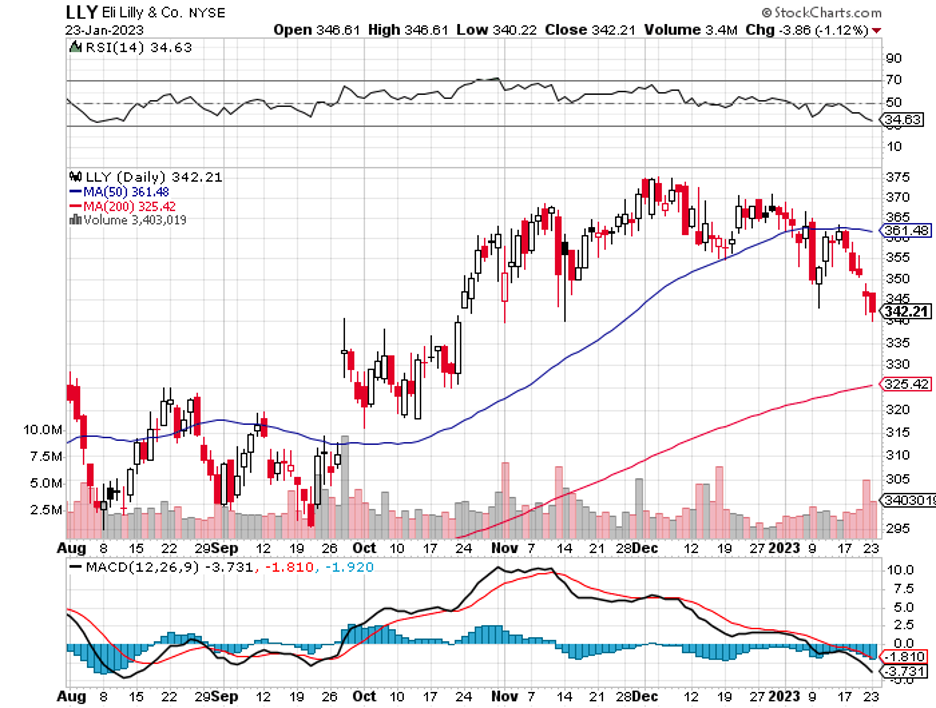The previous year was horrible for the stock market, with the S&P 500 dropping in value by roughly 19%, marking its first decline since 2018 and only the second time it sank since the 2008 financial crisis.
It was an even more horrid year for the biotechnology industry, with the flagship SPDR S&P Biotech ETF (XBI) sinking by 26% following its more than 20% decline in 2020—a catastrophic blow for such a promising index which delivered an impressive over 30% gains in 6 of the last 10 years.
Meanwhile, the stock prices in the large-cap pharmaceutical segment generally stayed buoyant. The “Big 8,” in particular—AbbVie (ABBV), Amgen (AMGN), Bristol Myers Squibb (BMY), Eli Lilly (LLY), Gilead Sciences (GILD), Johnson & Johnson (JNJ), Merck & Co (MRK), and Pfizer (PFE)—reported an average share price gains of roughly 15%.
Among the names in this list, Eli Lilly has become one of the go-to “safe” stocks during these turbulent times.
In contrast to the broader market, the company has performed exceptionally well in the last 12 months, with its share prices climbing by 12% within the timeframe.
One of the critical reasons that propelled Eli Lilly’s performance was the regulatory approval it obtained for Mounjaro, a diabetes treatment, in May 2022. Although this pharma giant has been hailed as the leader in the diabetes care segment for decades, Mounjaro is a game changer.
This newly approved diabetes treatment could blow any competitor out of the water, with peak sales estimated to hit $25 billion.
Besides diabetes, Mounjaro is also under review as a potential obesity treatment, signifying label expansions for this drug.
If this pushes through, then Eli Lilly would become one of the first movers in the diabetes and obesity markets, with only Novo Nordisk (NVO) standing as a realistic challenger. Based on the market size and the lack of competitors, the profit margins for these segments could be likened to those recorded by Pfizer and Moderna (MRNA) for the COVID-19 vaccines.
There are also other promising candidates in Eli Lilly’s portfolio. One is Donanemab, which is a potential treatment for Alzheimer’s disease. According to the company's Phase 3 study, its candidate delivered better results than Biogen’s (BIIB) approved Alzheimer’s treatment, Aduhelm.
Eli Lilly recently sent its atopic dermatitis treatment candidate, Lebrikizumab, for regulatory review in both the US and Europe. This marks another potential blockbuster for the company, with many treatments queued for review and possible approval by the end of 2023.
As for the company’s current portfolio, most of its products still report good results. For instance, sales of its cancer drug Verzenio rose by 84% year over year to record $617.7 million in the third quarter of 2022. Revenue for the diabetes treatment Trulicity climbed 16% year over year to reach $1.9 billion.
Another factor that makes Eli Lilly attractive is its dividend. Over the past five years, the company has doubled its payout. In 2022, the company disclosed a 15% hike to its dividend payouts. This marked the fifth consecutive year Eli Lilly implemented.
In December 2022, Eli Lilly shared its updated guidance for 2023. For 2022, the company projected that its top line would be between $28.5 billion and $29 billion. That represents a modest growth rate. Eli Lilly shareholders can anticipate better performance this year.
For 2023, the company estimates sales to climb to $30.8 billion. While that amount may appear underwhelming, it’s essential to keep in mind that this is a very conservative estimate. Eli Lilly is taking into account several concerns that may affect its growth, such as patent exclusivity losses and a decline in its COVID-19 sales.
Overall, Eli Lilly has proven itself to be a good and solid business that looks in excellent shape to continue delivering market-beating returns.
With a market capitalization of over $350 billion and several candidates in its pipeline, this company has a strong potential to be worth much more in the following years. Also, it’s critical to bear in mind that since 2020, Eli Lilly shares have skyrocketed by 176%, dwarfing the S&P 500’s 20%—a trend I expect to continue. I suggest you buy the dip.


